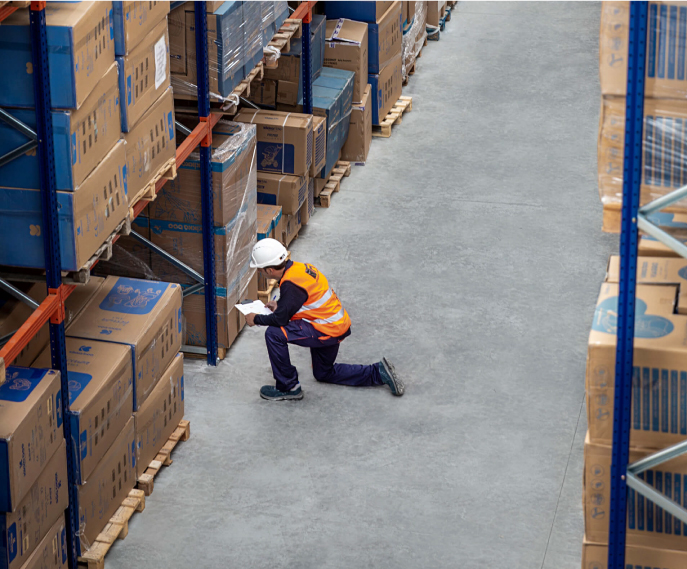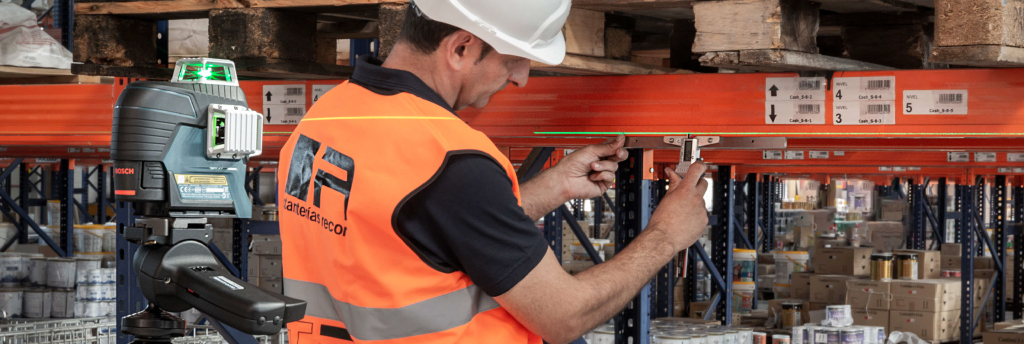
Improvements in logistics management processes and competitive pressures due to market forces compel companies to progressively optimise their fixed assets in order to free up financial resources, while they must simultaneously improve the level of service they provide for their customers.
This results in an increasingly demanding specialization of the equipment used subject to a progressive intensification of its own activity. Today’s storage systems are technically highly optimized assets. Due to their characteristics (thin-walled, open and perforated profiles), they have specific regulatory frameworks for their design, installation and use. Their main advantage is that they are very competitive solutions since they can support high loads at great heights with little material; their main disadvantage is that they are more sensitive to wear and tear or improper use, thus requiring an inspection and maintenance program to guarantee their performance.

Racking and storage systems are generally operated by handling equipment (forklift trucks, etc.) which constantly interact with them. This interaction, mainly during loading, unloading and transit operations, racking components can suffer impacts of varying intensities and frequency.
Other incidences also occur from using loading units, handling elements or due to unsuitable planning and design for storage needs. Lastly, using racking for a purpose other than which it was designed, changing its location, moving it or altering its layout can negatively affect these systems’ integrity.

As a result, damage to the racking’s structural elements creates a loss of function, which reduces its load capacity and affects its stability, creating high risk situations that could lead to very serious material damages and personal injuries.
In this context, significant effort has been made to develop regulations to systematise appropriate use and maintenance of this type of equipment, notably the training of staff responsible for its use.

In accordance with the provisions of Spanish Royal Decree RD 1215/1997 which sets out the minimum health and safety requirements for workers use of work equipment, storage systems are considered as work equipment and therefore they are subject to specific legislation concerning safety and risk prevention.
Furthermore, the Spanish National Institute for Occupational Health and Safety, in their Technical Safety Note NTP 852 Adjustable pallet racking, defines the risks associated with the use of racking and the preventive and protective measures to be adopted in each case.
Finally, standard UNE-EN 15635 Steel static storage systems. Application and maintenance of storage equipment , constitutes the most important normative document regulating the use and maintenance of storage equipment. It places special significance on training the users of storage systems to ensure safe warehouse operation. What is more, it establishes the requisite for storage equipment to be inspected by technically competent personnel at least once a year.
The main aim of the regulatory framework described above is to minimise risks inherent to the use of storage equipment and ensure the safe operation of the warehouse.

The user of the storage system is responsible for the safety of those who work in the equipment’s environment and for maintaining it in safe operating conditions. A risk assessment study is compulsory in order to minimise the possibilities of structural damage and its associated consequences. In this regard, standard UNE-EN 15635 establishes a list of responsibilities and competences covering all the parties involved.
As such, the user must consider the following responsibilities, amongst others:
- Compliance with applicable local and national regulations
- The provision of competent personnel who are trained in the use of handling equipment and storage systems.
- A management procedure that takes into account at least the following three points:
- Use of the storage system in accordance with its specifications.
- The appointment of a person responsible for storage equipment safety, PRSES (Person Responsible for Storage Equipment Safety)
- The completion of inspections, preventive maintenance and the repair of any damage encountered.
- Confirm that the environment is in accordance with the storage system’s specifications (humidity, lighting, ventilation, temperature, potential exposure to meteorological agents, etc.)

- Verify that the dimensions, weights, tolerances and clearances of the unit loads, the workflows, characteristics and means of circulation of the mechanical handling equipment, assembly of the storage system’s components and accessories, and the characteristics of load-bearing base plates and components all comply with the specifications for the configuration and use as detailed in the storage system’s original design.
- Ensure that the instructions provided by the storage equipment supplier are implemented correctly.
- Carry out regular inspections of the storage system over its lifetime to ensure that any damage that requires immediate action is dealt with according to the maintenance plan and any damaged components are replaced with replacements from the same manufacturer.
- Accept that there are safety implications that they must consider when realising any modifications to the logistics system (racking, unit load, handling equipment, handling method, work operative method, work personnel, etc.).

For their part the supplier must:
- Specify the technical limitations of the system in terms of its safe operating conditions, according to the load capacity and reported requirements.
- Provide, if required, an installation service carried out by experienced and properly trained installers This should include a post-installation inspection of the storage system and a formal certificate confirming that the work has been completed according to standards.
- Provide technical and safety advice to the storage system’s user regarding the effects of any changes in the use, load, geometric reconfiguration and any other functional parameters associated with the system in order to meet new requirements.
- Inform the user about the need for regular scheduled inspections and to implement a formal maintenance programme to deal with accidental damage.
- Supply warning notices with standardised characteristics that display the necessary information about the system’s limitations. Provide the user with information about the safe use of the equipment.

At your request qualified and experienced Estanterías Record staff will perform a rigorous inspection in accordance with standard UNE-EN 15635 and based on our own RTI methodology, which consists of:
- An evaluation of the general condition of your warehouse and the handling equipment currently in use:
- Conditions of the storage system support surface: planimetry, slopes, subsidence, deterioration, etc.
- Condition and suitability of the pallets in use.
- Clearances, tolerances and distribution of loads.
- Handling equipment in use: loading and unloading manoeuvres, circulation, flow and frequency of movements, whether it is suitable for the pallets and loads handled, etc.
- Whether the installation corresponds with the design and deployment plans, including the presence of warning notices in the correct locations.

- Consideration of general aspects featured in specific standards (NTP 852, RD 486/1997, RD 1215/1997)
- Adequate lighting for work usually carried out.
- Tidiness and cleanliness required to ensure the warehouse functions correctly.
- Adequate protective measures are in place.
- Training and behaviour of staff who work with the storage system.
- Verification of the storage system’s physical and functional condition.
- Damage assessment and classification of hazards associated with every part of the system.
- Operational recommendations in function of the hazards identified in relation to all the parts assessed.

Upon completion of the RTI process, the user will obtain:
- A preliminary evaluation with recommendations for immediate action if damaged components were identified and present a serious risk.
- A comprehensive report with the results of the inspection, the risks identified and the actions to be carried out.
- Signposting with adhesive labels placed on each damaged component to identify the observed risk.
- Handover of the inspection certificate, in accordance with standards, signed and stamped by Estanterías Record.
- Handover of the inspection record, if it is an initial inspection, or an updated version of the record including the latest evaluation in the case of subsequent inspections.
- Handover of the user, maintenance and safety manual associated with the installation for the warehouse staff’s reference.
- Recommendations for the preparation of an internal inspection programme.
- Technical advice for implementing good management practices in warehouse maintenance.
- Guidance for adopting operating procedures in the case of accidents and advice on how to investigate incidents in order to determine their causes.
- Training in safety and appropriate use of the work equipment.
- Telephone support available 24/7 into any aspect related to the technical inspection.
- Who do these regulations affect?
All users of storage systems and equipment. - How do the regulations affect my company?
Standards UNE-EN 15635 and NTP 852 establish that users of storage equipment are responsible for safety in the warehouse. - What do I need to do to maintain a safe warehouse?
The best means of detecting any risks associated with your storage equipment is to perform regular inspections in accordance with regulations. - How often do I need to carry out inspections?
This depends on the type of installation and frequency of use, but at least once a year. - Who can carry out inspections?
Technically competent personnel. Estanterías Record has trained experts accredited to perform these inspections. - Why should my company entrust this service to Estanterías Record?
Because we have experienced specialists who have been specifically trained for this service. Also because we are a manufacturer of the equipment being inspected, in accordance with standard UNE-EN 15635. - Will the inspection affect our daily activities?
Estanterías Record’s inspectors will examine your installations without interfering with your daily activities. - Will I receive documentary evidence of the results of the inspection?
Yes, Estanterías Record will provide a certificate of inspection as well as a detailed report. - How can I request a Technical Inspection of my warehouse?
Please contact Estanterías Record on the free telephone number 900 466 888, or by using the following link to access the contact form.
*Required fields

